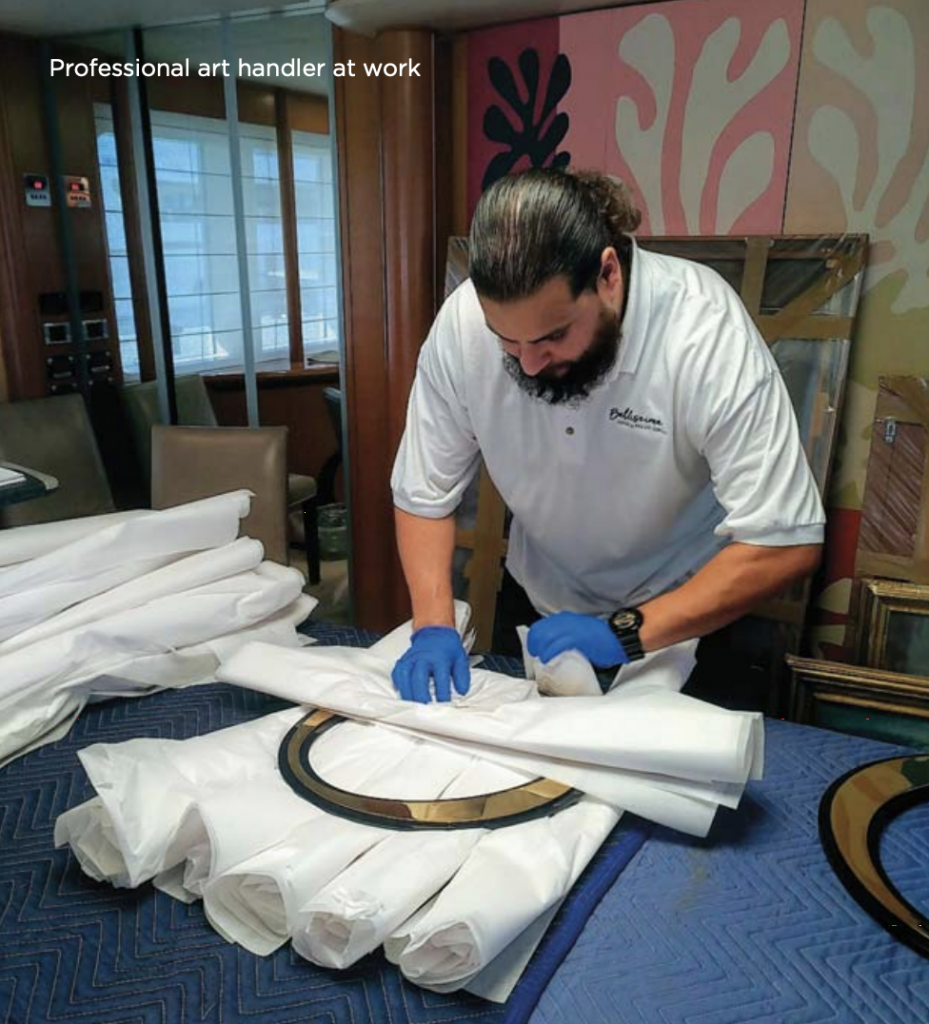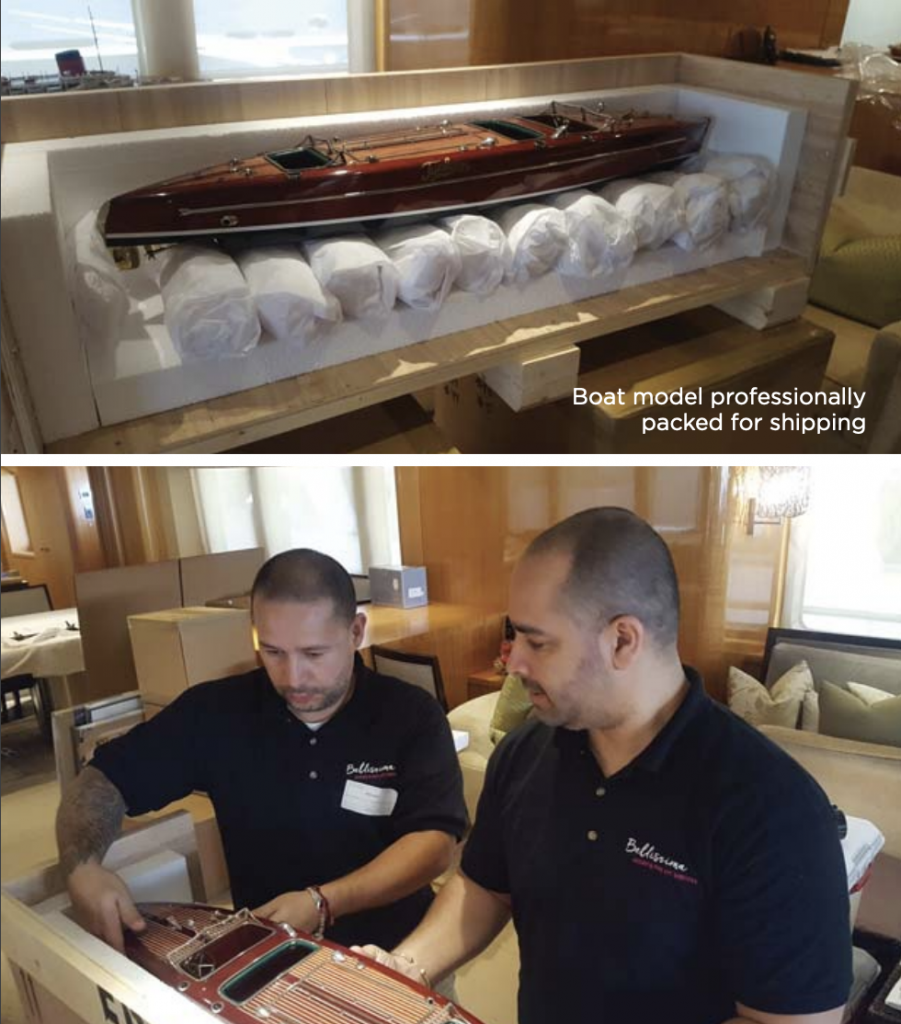June/July 2019 – The Compass Magazine “PROTECT THAT PICASSO: CARING FOR FINE ART ON BOARD A YACHT”

PROTECT THAT PICASSO: CARING FOR FINE ART ON BOARD A YACHT
by Susan D. McGregor, CEO, Bellissima Luxury & Fine Art Services for “The Compass Magazine”
 When a yacht owner incorporates art from his personal collection, the daily responsibility to maintain the collection falls to the crew. Art may be one of the few assets onboard that increases in value over time. Therefore, crew training on the basics of art collection care and management is of vital importance to ensuring the safety of the collection.
When a yacht owner incorporates art from his personal collection, the daily responsibility to maintain the collection falls to the crew. Art may be one of the few assets onboard that increases in value over time. Therefore, crew training on the basics of art collection care and management is of vital importance to ensuring the safety of the collection.
Recent examples of damage to high-value works of art highlight a lack of knowledge among crew, which can result in negligence. Such is the tale of a yacht owner’s children who threw their cereal at a multimillion-dollar Jean-Michel Basquiat painting because they found it scary, and then the crew who wiped the painting off to clean it up. This is one of several maritime mishaps underscoring the importance of implementing training on industry standards for art collection management on yachts.
Characteristics of a collection
Collections are as diverse as their collectors, and high-value collections typically share characteristics such as: cultural and/or historical importance, limited availability in the marketplace, highly sought-after artists, origin, rarity, or provenance. Understanding the nature of the collection and steps crew can take to protect it will help those responsible to make good decisions and communicate important information when the need arises.
Know exactly what’s on board
The importance of maintaining an accurate inventory of art collection items on board cannot be over-emphasized. At minimum, an inventory includes the following: physical description (medium, year, title, artist’s name) photos, condition reports, appraised values, physical location on the yacht, and dimensions. In situations where items are removed temporarily, such as when works are in storage during a refit, this documentation can safeguard the integrity of the collection. When a yacht is sold, it is critical to document what is on the yacht, which objects go with the sale and which do not. Items not specifically identified may unintentionally be included, if not itemized with inventory excluded from the sale. Continuously updating inventory, especially when specific items are added, removed, or damaged is important for accurate records. Insurance policies will require a schedule or inventory.
Document, document, document
In addition to maintaining an up-to-date inventory, it is important to maintain records of how objects are acquired. Crew should maintain a binder with full documentary evidence of art ownership, provenance, and tax status, including purchase and export documentation stamped by the relevant tax authorities when art is purchased or transported internationally. The binder may also be used to transfer knowledge during a transition of crew.
The Jaime Botin case illustrates the complexities of transporting art on yachts. The 1906 Picasso artwork, “Head of a Young Woman” was seized by French Customs officers in July 2015 in Corsica when they boarded his schooner, ADIX. The painting had been prepared for delivery and Botin was accused of reportedly attempting to smuggle the painting into Switzerland. Although the €26 million painting had been purchased in 1977 and had been in Botin’s possession for more than 30 years, it was declared a cultural treasure by the Spanish National Court in May 2015 and had been refused an export permit prior to the seizure.
Security is essential
Another important component of protecting valuable artwork is the yacht’s security system. A working alarm system is essential and most likely an insurance requirement. High-value works are typically fitted with sensors or virtually unnoticeable GPS tracking devices that can be used to recover the works after a theft.
Although art theft from a yacht is rare, it does occur, such as in Antibes when a Picasso was stolen off the 75m superyacht CORAL ISLAND. The vessel was undergoing repairs in a shipyard when the painting, which normally was attached to an alarm, had its alarm disarmed and was deinstalled so painters could work on the wall behind it. The piece was locked in a separate room that had no alarm instead of immediately being removed from the yacht and placed into secure storage. The Picasso vanished; however, an alarm-protected Matisse in the same room was not touched. Coincidentally, the shipyard’s video surveillance equipment had been out of action for three months.
Crew must ensure safety precautions are taken to protect the owner’s property both when the vessel is sailing and when it is not. This is especially true during refit or maintenance periods when non-crew workers are working on the yacht.
Handling art
When art is moved on or off a yacht, crew is responsible for overseeing the care, custody and control of each object. This includes documenting the chain of custody and condition of each work. Handling in and out procedures are critical as art is at the greatest risk of damage or theft during transport.
The following procedures for handling in can help to mitigate risk and protect the owner in the event of damage:
• Plan for arrival in advance
• Identify obstacles along the path of access
• Require a condition report from the shipper before art/ furnishings are shipped
• Ship directly to yacht or to another land-based location (i.e. fine art warehouse)
• Open and visually inspect upon receipt
• Condition report & photograph the object while unpacking it
• In the event there is damage and you file a claim, keep all packaging materials (and photos).
When packing and handling out, the following procedures offer the safest method of removing art and fine furnishings:
• Use professional art handlers to pack
• Crate high value or fragile items
• Require a condition report and photographs prior to packing
• Discuss the de-installation, packing and removal process with fine art services company
• Identify obstructions to the removal of oversized works and furniture and note specialty equipment required (i.e. crane).
During both handling in and out, using technicians trained in the packing and transport of fine art will mitigate risk of damage.
Art placement on board
Superyachts offer a climate-controlled environment that can be as desirable as a museum and highly conducive for displaying art – with some additional precautions required. Sunlight, humidity, sea (salt) air, motion, and temperature are dangerous to fragile works of art. Traffic patterns and human interaction are also potential threats. Therefore, climate control, correct placement onboard, and (artificial) lighting are important to bring out the beauty of art while protecting it from damage. Photography, watercolors and drawings are more vulnerable than oil-based art and sculptures and need to be protected from natural light. Framing using a highly protective anti-glare, anti-reflective glass and hanging works away from direct light sources, vents, or areas that are not climate-controlled will reduce risk of deterioration.
Art should be installed using marine-grade hardware to minimize movement, especially during large swells or inclement weather. The same goes for fixing small sculptures and objects, which is where “museum glue” (also called gel, wax or putty) comes in: a clear product that fixes objects to surfaces (though not permanently) to stop them shifting in a swell.
Storage ashore
Selecting a proper storage facility for art and fine furnishings extends protection while off the yacht. Consideration should be given to security/controlled access, climate-controlled environment, backup generator during loss of power, hurricane-rated, pest control, availability of private unit or general warehouse.
Basic training on art collection management will assist crew in protecting objects that are important to the owner from both a financial and personal perspective.
Susan McGregor is CEO of Bellissima Luxury & Fine Art Services, based in Fort Lauderdale. Bellissima provides installation, packing, custom crating, shipping and storage of fine art and furnishings. For more information, visit www.bellissimafineart.com.
Recent Posts
What yacht crew should know about caring for art on yachts. Q&A with Bellissima Luxury & Fine Art Services.
Q. Art is a huge part of the personalization of a yacht, from paintings to sculptures to the furniture and even the carpet. What one or two key things should crew know about the “art” onboard a yacht? A. We use the phrase “care, custody and control” a lot. With that in mind, the most […]
Six Tips for Moving Into a New Condominium
Moving Into a New Condominium 1. Plan Ahead Create a Move-In Timeline. This should include things such as deliveries of new appliances, furniture, art installation, etc. Make a floor plan of where your larger belongings are going to be placed, including furniture, electronics, and art! 2. Get Familiar with the Logistics Is there parking for […]
Provenance: What It Is and Why It Matters.
Provenance: What It Is and Why It Matters. From the French word, provenir, meaning “to come from,” provenance is the chronology of the ownership, custody, or location of an object. Provenance is the documentation used to authenticate a particular art piece. These documents are used in general to establish authenticity, ownership, and value. In addition, provenance documentation can […]
Client Testimonials
Hello Everyone - greetings from Bangkok, where the art shipment has just been delivered! Thank you all for making this happen with such a smooth, well planned and high-quality operation. From beginning to end you provided the greatest benefit any service can...
We have been working closely with Susan and her team at Bellissima since 2017 and I must say we have had a fantastic experience. Very professional outfit and very easy to deal with. We have stored some pieces of art with quite...
I used Bellissima to pack, store and move our artwork, lamps and collectibles. I had heard they were great from other customers, but they were more than "great", they were wonderful. They are careful, responsive, dedicated and professional. I would highly, highly...

